It is not uncommon for people confronted with a tragic death to make unsupported allegations. Most organisations confronted with such an allegation in an emotionally charged atmosphere, let it pass. But logging company Samling was clearly hurt by the statements, particularly those from Nick Kelesau, that he believed his father had been murdered.
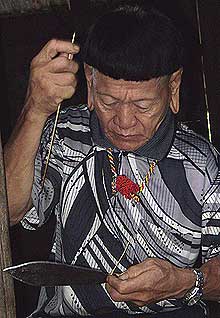 “Tell Nick to tell the truth,” James Ho told me in the Samling office at the end of my meeting with him before I set off to investigate Kelesau Naan’s death and hear the Penan’s side of the logging story.
“Tell Nick to tell the truth,” James Ho told me in the Samling office at the end of my meeting with him before I set off to investigate Kelesau Naan’s death and hear the Penan’s side of the logging story.
A tall thin man who could be a chief executive in any major company in the world, Ho, had just given a strong presentation on the operations of his company, the thrust of which was that Samling would operate within the laws of the land and do what it was authorised to do – log the forests and run plantations.
At that time I knew nothing of the forged letter. I called Lim Hon Guan to get him to arrange a guide for me to trek through the mountains from the airport at Long Lellang to Kelesau’s hamlet of Long Kerong. Hon did not mention the letter at that time.
But he did tell me about his people’s dreams about Kelesau’s death. Kelesau’s skeleton was discovered partly as a result of a dream. On Dec 10, some clothing and a woven bag, stuck on a tree, were spotted in the upper Segita river by Kelesau’s brothers Kata and Agin. Because of very heavy rain, and the rise in the rivers, the brothers could not return to the area.
A week later, the headman of the village of Long Spigen, Pelutan Tiun, dreamt that Kelesau had told him that he could be found on the banks of the Segita River. Pelutan’s son Thomas accompanied by friends, returned to the area, first finding a rib bone and then Kelesau’s beads and other bones.
The remains were found near a deeper part of the 6-metre wide river. Although the Penan are now strongly evangelical Christians, old beliefs die slowly. I was told that in Penan tradition, when someone is missing because of unnatural causes, the people will know it through their dreams, or the weather. So they believed that the bad weather around the time of Kelesau’s disappearance was an omen.
A Long Kerong elder and close friend of Kelesau, Kelasih Payah dreamt that the headman had been attacked. This was consistent with one fact – a broken arm bone. Hon’s mother, Apeng Belait, who is in her 50s, had a dream where Kelesau told her, “I’m here. I’m just inside the river.” Apeng woke up screaming because she saw the headman in the water.
She had dreamt that he said, “You people search for me too far away from here. I’m just here in the river.”
Tribal wars
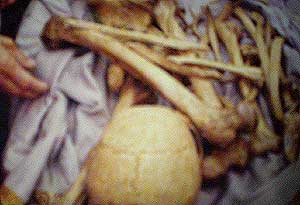 The broken forearm led to all sorts of speculation. There were suggestions that it had been cut by a sharp object – perhaps a parang which every forest native carries in his or her travels. But the first man to begin the search, Parry Dok, who was out hunting when he ran into Kelesau’s wife returning to the village to report the incident, said he thought the bone had been broken by being struck by a blunt object like a stick.
The broken forearm led to all sorts of speculation. There were suggestions that it had been cut by a sharp object – perhaps a parang which every forest native carries in his or her travels. But the first man to begin the search, Parry Dok, who was out hunting when he ran into Kelesau’s wife returning to the village to report the incident, said he thought the bone had been broken by being struck by a blunt object like a stick.
“How could you tell if he’d been struck by a stick, or fallen against something and broken his arm?” I asked. He did not have an answer. The autopsy, conducted for the police, concludes that the cause of death cannot be established.
Kelesau was an old man. He had gone into the jungle alone to hunt. Weather conditions were bad. The probability of an accident, would have to be strong. But in the highly charged atmosphere of the battle over the forests, it is understandable that local people believe he was murdered.
Heading the police investigation is a relatively junior 27-year-old Inspector Sumarno Lamundi. Because of the concerns raised by the community, police exhumed the skeleton but gained little useful information. Police have few clues to work with and police spokesman Deputy Superintendent Jonathan Jalin said the claims of foul play were all hearsay.
In recent times, there had been clashes between the Penan and others and Kelesau played a leading role in trying to defuse tensions. In mid June 2007, a party of Penan from the village of Long Sait ran into a group of Samling workers conducting survey work in land the Penan claim.
According to a Penan report on the incident, they told the group, led by a Kenyah man, Dungau Lenjau, to leave.
“We did not hurt or beat anybody,” the Penan said. “Nevertheless, we do not deny that we took the items/goods listed below.” The statement then acknowledges that 10 kilos of sugar, Maggie noodles, one bottle of cooking oil and two small Milo tins, a fishing net, a shirt and three bags of rice, and other things were taken.
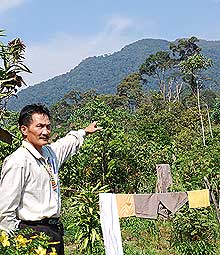 The following day, four Penan went to the Kenyah village of Long Siut to do marketing. They were informed by the shopkeeper that Dungau Lanjau was very angry with the Penan and challenged the Penan to a fight. Later that evening, four Kenyah men approached the Penan and challenged them to a fight.
The following day, four Penan went to the Kenyah village of Long Siut to do marketing. They were informed by the shopkeeper that Dungau Lanjau was very angry with the Penan and challenged the Penan to a fight. Later that evening, four Kenyah men approached the Penan and challenged them to a fight.
The headmen of Long Sait, Bilong Oyau and Kelesau wrote to the manager of the Samling camp, seeking to prevent any further incidents “which will aggravate the feeling of unhappiness for the company, the Kenyah and the Penan people.” But according to the Penan, a meeting called to resolve the situation ended in chaos.
The Penan have a long-standing reputation as peaceful people. While the Iban were notorious as headhunters and other tribal groups fought wars with each other, the Penan avoided conflict, roaming the remote reaches of the jungle in small groups.
A Lundayeh man, Jayl Langub, who speaks Penan and worked with them as a government officer for 30 years, says the Penan are peaceful, but argumentative. “I don't think I ever won an argument with them.” He says in all his time with them he never saw a Penan man hit another Penan man but he did see a man smash his blowpipe against a tree in anger during an argument.
Others confirm the Penan are shy and peaceful. If attacked, they retaliate. One belief is that they can walk silently in the forest with their blowpipes and kill unseen. They are reputed to have the most deadly blowpipe dart poisons and some are able to load their pipe with three darts and fire them rapidly, a feat no other people have mastered.
Logging for tainted timber
But the older Penan, who have no formal education, are vulnerable. In late June last year, the Long Spigen headman Pelutan Tiun was approached by two officials while he was sick in the Marudi District Hospital and according to a statement he has lodged with police, pressured to thumbprint a statement written in English saying he was withdrawing from the Penan land claim and another appointing a new solicitor.
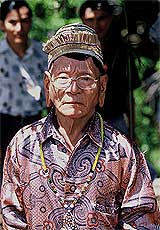 The Penan’s current blockade stands at Long Benalih on a road Samling plans to build to the regional, airport-serviced village of Long Lellang. When I arrived at the tiny settlement of Long Benalih, most of the community leaders were off gathering gaharu wood.
The Penan’s current blockade stands at Long Benalih on a road Samling plans to build to the regional, airport-serviced village of Long Lellang. When I arrived at the tiny settlement of Long Benalih, most of the community leaders were off gathering gaharu wood.
But one elder, Henneson Bujang, was there to tell me he and the community would maintain the blockade and risk arrest. He has been arrested and jailed previously but says he is not frightened.
“This is my place, our life. If there is no forest there is no Penan,” he said and his words were echoed by his sons Jimmy Henneson, 24, and Addonia Henneson, 21. A year earlier, Kelesau had made it clear that he and his people belonged to the forest. “The Penan are like mushrooms. They come from the ground,” he told me.
Henneson says although his community is no longer nomadic, they want the forest to remain. He believes that if the region is left untouched, the community can get income from tourists, guiding them to the nearby stunning Sela’an waterfall or on trekking or wildlife expeditions. The flimsy, unmanned blockade is a two hour trek up a very slippery, muddy track from the village.
Samling chief operating officer James Ho says Samling will not breach or remove any blockade.
“It can be a string, a piece of log, a sign. We never remove them.” But the company does not have to. Over the years, the government authorities, the police and army have cleared the way. And Samling is of course happy to co-operate with such authorities, providing occasional accommodation for Sarawak Forestry Corporation employees monitoring the blockade.
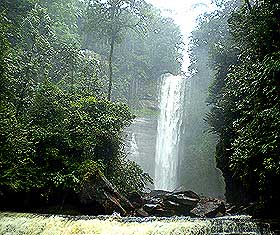 Penan complaints to the Malaysian Human Rights Commission (Suhakam) state that in all the disputes over land, the police, especially the Police Field Force, side with the timber companies.
Penan complaints to the Malaysian Human Rights Commission (Suhakam) state that in all the disputes over land, the police, especially the Police Field Force, side with the timber companies.
There are only 10,000 Penan in total, of whom only about 300 to 400 remain truly nomadic, but hundreds have been arrested at blockades since the 1980s. The central issue is the non- recognition of Penan land rights. The High Court claim for the land was lodged in 1998 but in October 2002, Kenyah representatives made claims to the land and the matter was stayed, awaiting a determination from the Native Court.
With no hearing and no determination, logging continues on Penan-claimed land. Some companies are much more aggressive than Samling, with the secretive Shin Yang having one of the worst reputations for intimidatory behaviour. Shin Yang refused to respond to questions about its actions.
But one of the lawyers mounting the Penan case, See Chee How sees little difference between one logging company and another.
“They have concessions bordering each other,” he says. “Shin Yang and Samling are equally bad. Logging on the native peoples’ land is already illegal. The timber is already tainted. You cannot say that it is legal.”
Dead Penans tell no tales (Pt 1)
PAUL MALONE, 60, has been a journalist for over 30 years in Australia. The above article, which first appeared in the Canberra Times, is based on his trip to research logging in the upper reaches of the Baram River in Borneo which he first visited in 1974.

